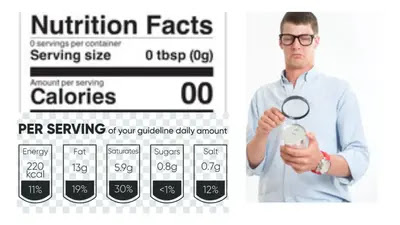Unlocking the Secrets of Nutrition Labels: The First Thing You Should Check
While inspecting a nourishment mark, the principal thing to search for is the Serving Size and Servings Per Compartment.
Serving Size:
The serving size lets you know how much food or drink the sustenance data depends on.
It's pivotal to look at the serving size recorded on the name with the part size you really consume. This helps you accurately assess the nutritional content you're getting.
For instance, in the event that a serving size of an oat is 1 cup, yet you normally eat 2 cups, you really want to twofold every one of the supplement values recorded on the name too.
Servings Per Container:
This shows the number of servings that are in the whole bundle or holder.
On the off chance that the bundle contains various servings and you consume the whole bundle, you'll have to increase the supplement values by the number of servings to ascertain the absolute dietary admission.
Calories:
After determining the serving size, check the calories per serving.
Calories measure the energy provided by a specific serving of food. Knowing the calorie content helps you manage your overall calorie intake, which is important for weight management.
Nutrients to Limit:
Look for nutrients that should be limited in your diet, such as:
Saturated Fat and Trans Fat: These types of fats can increase the risk of heart disease. Aim to consume less than the recommended daily limit.
Sodium (Salt): Excessive sodium intake can contribute to high blood pressure and other health issues. Choose foods lower in sodium content.
Added Sugars: Foods with high added sugar content can lead to weight gain and increase the risk of chronic diseases like diabetes. Limit your intake of added sugars.
Nutrients to Include:
Pay attention to nutrients that are beneficial for your health, including:
Dietary Fiber: Aim for foods high in fiber, as it supports digestive health and can help lower cholesterol levels.
Vitamins and Minerals: Check for essential nutrients like calcium, iron, vitamins (A, C, D, E), and others that contribute to overall well-being.
% Daily Value (%DV):
The %DV shows how much a nutrient in a serving contributes to your daily diet based on a standard 2,000-calorie-per-day diet.
Use %DV to quickly assess if a food is high or low in a particular nutrient. For example, 5% DV or less is considered low, while 20% DV or more is high.
This information helps you make informed choices about the nutritional value of foods relative to your daily dietary needs.
Why is the serving size the first thing to check on a nutrition label?
How does knowing the serving size help in calculating total calorie intake?
What information on the nutrition label depends on the serving size?
Why is it important to compare serving sizes across similar products?
How can serving size affect your perception of a food’s nutritional value?





.png)



0 Comments
please do not enter spam link in the comment box.